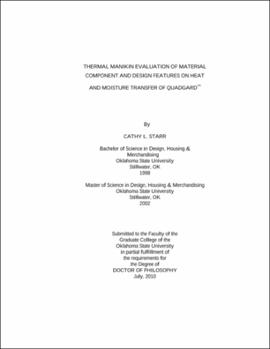| dc.description.abstract | Findings and Conclusions: Test results from Phase 1 indicated that there was a significant ballistic material effect for intrinsic clothing insulation, F(1,12) = 191.90, p <.0001) and intrinsic clothing evaporative resistance, F(1,12) = 104.59, p <.0001). For micro-climate temperature there was a significant two-way armor system-by-ballistic material interaction and the simple effects were significant for ballistic material, F(1,12) = 9.34, p = .01). Since the moisture retention data did not satisfy the assumption of homogeneity of variance, a logarithmic transformation was performed on the data. Analysis of the log transformed data showed a significant ballistic material effect for moisture retention, F(1,12) = 19.31, p = .0009). Test results from Phase 1 indicated a significant armor system effect for intrinsic clothing insulation, F(2,12) = 5.71, p = .0181). For micro-climate temperature there was a significant two-way armor system-by-ballistic material interaction and the simple effects were significant for armor system, F(2,12) = 30.30, p <.0001). Phase 2 results indicated that there was a significant ballistic material effect for intrinsic clothing insulation, F(1,20) = 51.08, p <.0001) and intrinsic clothing evaporation, F(1,20) = 31.72, p <.0001). Test results from Phase 2 indicated that there was a significant armor system effect for three dependent variables: 1) intrinsic clothing insulation, F(4,20) = 320.22, p <.0001); 2) intrinsic clothing evaporative resistance (Recl), F(4,20) = 293.63, p <.0001); and 3) micro-climate temperature, F(4,20) = 83.98, p <.0001). The moisture retention data did not satisfy the assumption of homogeneity of variance, a logarithmic transformation was performed on the data. Analysis of the log transformed data showed a significant armor system effect for moisture retention, F(4,20) = 107.37, p <.0001). The findings from this study indicated that fabric and garment design influence the thermal burden of the garment ensemble. The findings give merit to and show the benefit of modularity, especially for military personnel who will be in or driving an armored vehicle. | |
